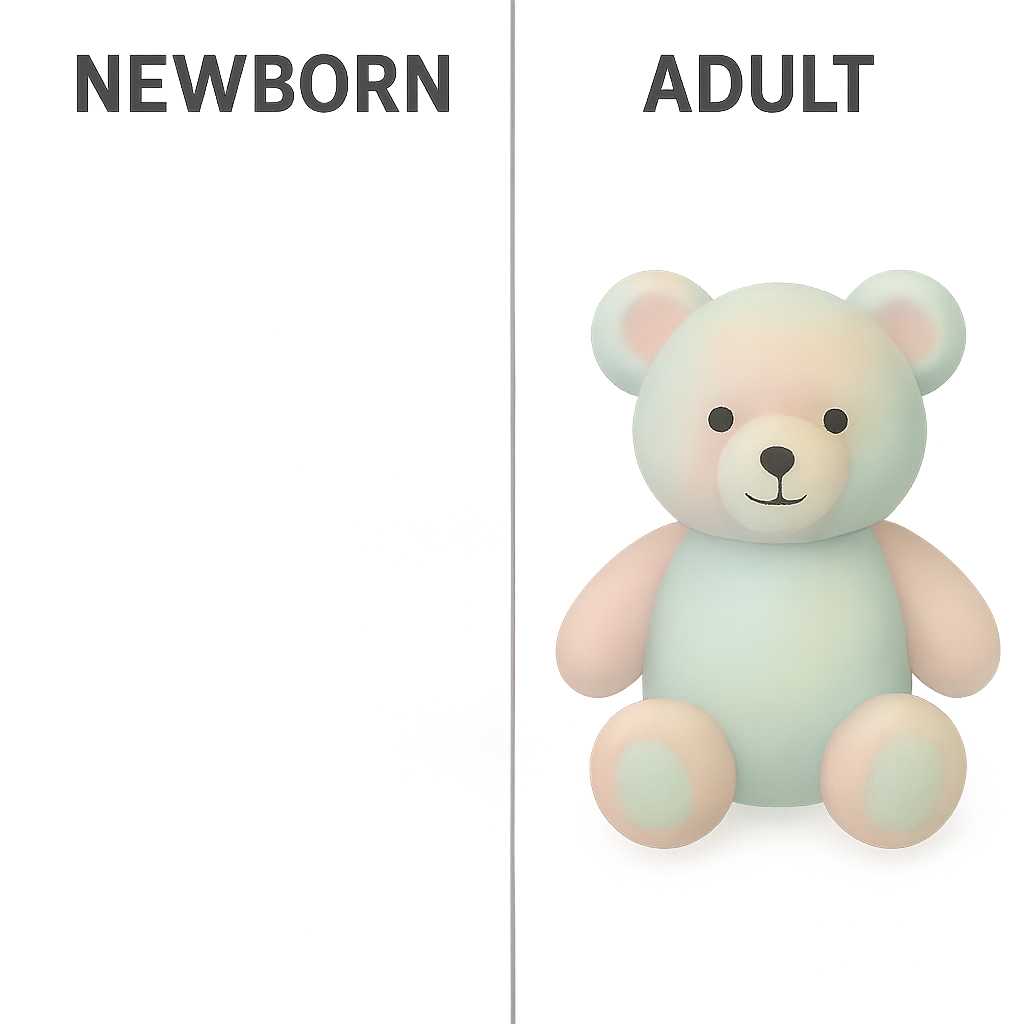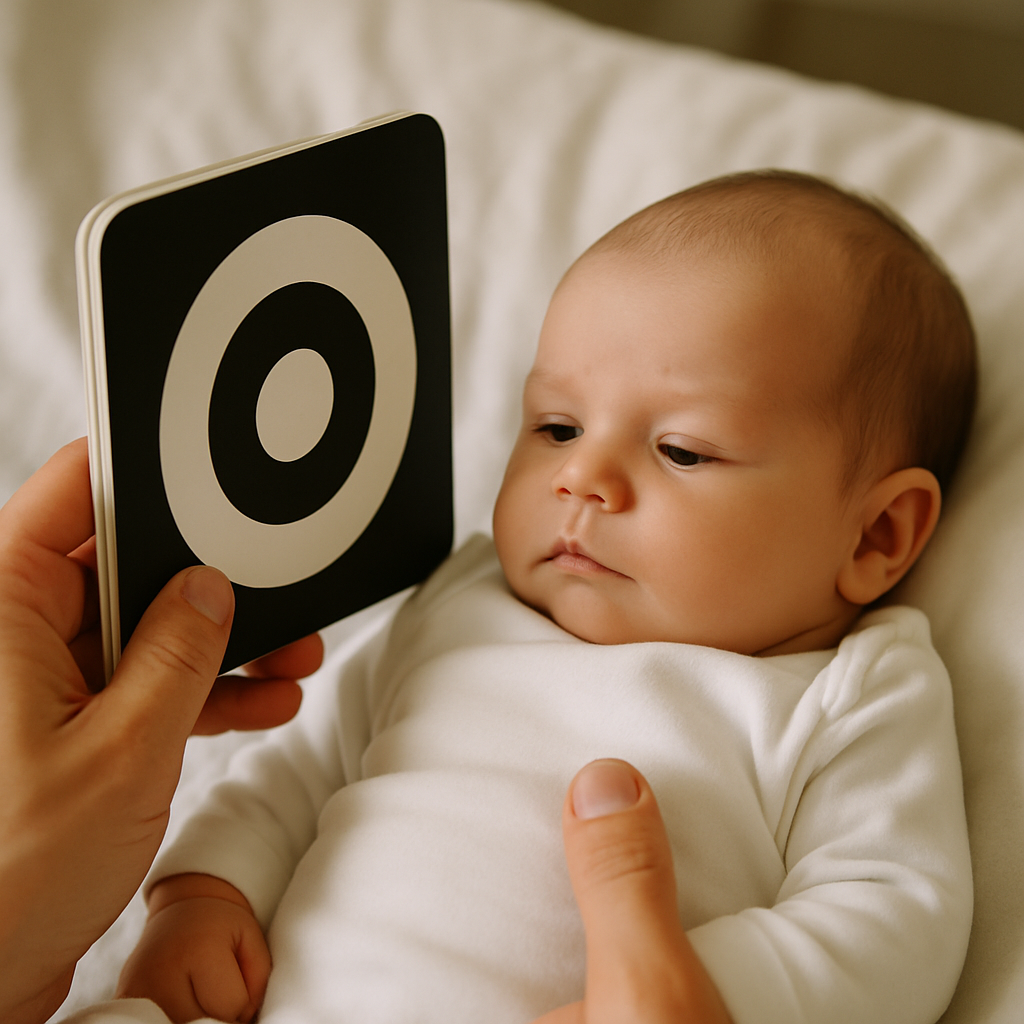Newborns are drawn to bold, black-and-white patterns, staring at them up to eight times longer than soft pastels. In their first 14 weeks, these stark contrasts are the primary “language” their eyes understand, sending strong signals to the brain to enhance focus, tracking, and learning. This guide explores the science behind high-contrast books and offers practical ways to incorporate them into daily routines.
- Why do newborns see only black and white, and what counts as “high contrast”?
- How do high-contrast books fuel brain development beyond vision?
- When should you start using high-contrast books, and how long do the gains last?
- How can you use high-contrast books daily without overstimulating your baby?
- Which books, cards, or DIY options work best?
- How can high-contrast reading fit into everyday routines?
- What myths about high-contrast books keep parents up at night?
- How will you know high-contrast reading is paying off?
- Your Top Questions, Answered
- Final Thoughts
Why do newborns see only black and white, and what counts as “high contrast”?
Newborns don’t see only black and white, but their vision is highly sensitive to high-contrast patterns due to underdeveloped retinal cones, which are roughly 5% as effective as adults’ for color detection. This makes bold, high-contrast images—like black shapes on a white background—stand out vividly compared to muted colors.
- High contrast means a stark difference in brightness, such as black-and-white stripes, spirals, or simple shapes.
- A 2023 study confirms infants focus longer on high-contrast patterns, enhancing early visual and cognitive development. Discover Infant Visual Perception.
- Common terms include bold patterns, monochrome visuals, or high-luminance graphics.
These patterns stimulate the retina and visual cortex, fostering focus and tracking skills, especially in the first 14 weeks.

How do high-contrast books fuel brain development beyond vision?
High-contrast books do more than catch a newborn’s eye—they spark broader brain development by stimulating neural pathways beyond just vision. Here’s how:
- Neural Stimulation: The stark black-and-white patterns in high-contrast books activate the retina and visual cortex intensely, promoting myelination—the process that insulates nerve fibers for faster signal transmission. A 2022 study shows that high-contrast stimuli enhance neural connectivity in infants, supporting attention and processing speed.
- Cognitive Growth: These visuals encourage longer focus, strengthening early attention networks. This lays a foundation for skills like problem-solving and memory, as visual engagement primes the brain for learning.
- Multisensory Boost: Pairing high-contrast images with a caregiver’s narration adds auditory input, reinforcing language networks. This cross-modal stimulation helps babies connect visual and verbal cues, enhancing early language development.
- Motor Skills Support: When used during tummy time, high-contrast books encourage head lifting and reaching, linking visual stimulation to motor development.
These combined effects make high-contrast books a powerful tool for wiring a newborn’s brain. Explore more at Sensory Play Ideas.
When should you start using high-contrast books, and how long do the gains last?
Start Date: Begin using high-contrast books from birth. Newborns’ eyes are primed to detect stark black-and-white patterns, which stimulate visual and neural development right away.
Duration of Benefits:
- Birth to 14 Weeks: This is the peak window when high-contrast books are most effective, as infants rely heavily on contrast to engage their developing retinas and visual cortex.
- 15 Weeks to 5 Months: Benefits continue but gradually taper as color vision matures. High-contrast books remain supportive, especially for tracking and focus.
- Beyond 5 Months: Transition to colorful books as babies start responding to hues, but high-contrast favorites can still provide comfort and engagement.
Practical Tip: Pair with tummy time to boost motor and visual gains simultaneously.
Special Cases: Preemies or babies with low vision often enjoy an extended window—check with a pediatric ophthalmologist for personalized pacing. High-contrast pages also pair beautifully with Tummy Time for simultaneous motor and visual gains.
How can you use high-contrast books daily without overstimulating your baby?
To incorporate high-contrast books into your newborn’s routine without overwhelming them, follow these concise strategies tailored to their sensitive visual system:
- Right Distance: Hold the book 8–12 inches from your baby’s face, matching their natural focal range for clear viewing
- Short Frequent Sessions: Use a “3×2 recipe”:
- Three daily sessions (e.g., morning, midday, bedtime).
- Two minutes each, guided by baby’s cues like smiling or tracking. Short bursts keep engagement high without overwhelming their sensory system.
- Watch for Overstimulation: Pause if you see gaze aversion, hiccups, or yawning. Cuddle, then try again later to keep it calm and engaging.
- Fit into Routines:
-
Morning: Show a page during cuddles to boost attention.
-
Tummy Time: Prop the book upright to encourage head lifting
-
- Narrate Simply: Describe images (e.g., “Big black star!”) to add language exposure without overwhelming.
Limit total daily use to 10–15 minutes to prevent fatigue, ensuring consistent but gentle stimulation.

Which books, cards, or DIY options work best?
Here are top picks for high-contrast books, cards, and DIY options, chosen for newborn engagement and practicality:
High-Contrast Books
These board books are sturdy, engaging, and designed for newborn visual development:
| Title | Format | Price | Durability | Standout Feature |
|---|---|---|---|---|
| Look, Look! by Peter Linenthal | Board | $8 | ★★★★☆ | Bold animal silhouettes, simple text |
| Black on White by Tana Hoban | Board | $7 | ★★★★☆ | Thick pages, clear shapes, accordion-style for tummy time |
| Spots and Dots by Chez Picthall | Board | $6 | ★★★★☆ | Repeating patterns to aid tracking |
| Baby Sees First Colors by Akio Kashiwara | Board | $10 | ★★★★☆ | Introduces red for 3-month transition |
| Hello, Baby Animals by duopress labs | Board | $8 | ★★★★☆ | High-contrast animal images, minimal text |
Why Books? Great for bonding and language exposure during caregiver-led sessions.
High-Contrast Cards
- Lovevery Art Cards ($10): Laminated, durable, ideal for tummy time or stroller.
- Wee Gallery Cards ($13): Bold animal patterns, easy to clean, portable.
- DIY Cards: Print free high-contrast designs (e.g., from Childreach), cut into 5×5-inch squares, and laminate.
Why Cards? Perfect for quick, independent gazing and portability.
DIY Options
- Printable Tent: Print black-and-white patterns (300 dpi), laminate, and form a tummy-time tent.
- Homemade Book: Use black-and-white cardstock, glue bold shapes, and bind with a ring for a custom book.
- Library Lending: Many libraries offer free high-contrast board books.
Why DIY? Budget-friendly (under $5) and customizable for family involvement.
Comparison
| Feature | Books | Cards | Toys |
|---|---|---|---|
| Language Exposure | High | Low | Low |
| Portability | Medium | High | High |
| Washability | Medium | High | Varies |
| Independent Gaze | Good | Excellent | Good |
Top Pick: Start with Black on White for tummy time and Lovevery Cards for portability. DIY cards are great for budget-conscious parents.
Avoiding Overstimulation: Show one image at a time, use in calm settings, and stop if the baby seems disengaged. Transition to colorful books around 4–5 months as vision matures.
For more budget ideas, check out DIY Baby Toys.
How can high-contrast reading fit into everyday routines?
High-contrast books can seamlessly integrate into a newborn’s daily routine. Here’s how to incorporate them effectively, based on infant visual needs:
- Morning Cuddle (5 minutes): During morning feeds or cuddles, hold a high-contrast book 8–12 inches from your baby’s face. The natural light helps anchor their circadian rhythm and boosts joint attention. Example: Show a page of bold shapes while describing them softly (e.g., “Look at the big circle!”).
- Tummy Time Boost (2–3 minutes): Prop a high-contrast book upright during tummy time sessions. This encourages head lifting, strengthening neck and shoulder muscles, while engaging their eyes. Use a book like Black on White for its sturdy, standable design.
- Bedtime Wind-Down (2–3 minutes): Read a high-contrast book before bed to calm your baby. Unlike screens, monochrome pages emit no blue light, supporting melatonin production for better sleep, as noted by pediatric guidelines. Confirm with AAP Screen Time Recommendations. Narrate gently to add soothing language exposure.
Tip: Limit total daily use to 10–15 minutes across 2–3 sessions to avoid overstimulation. For a big picture on active learning, compare it with screen time in Play vs. TV.
What myths about high-contrast books keep parents up at night?
Several misconceptions about high-contrast books can cause parental concern, but recent evidence debunks them:
-
Myth: “Babies outgrow high-contrast books in weeks.”
Reality: While peak benefits occur from birth to 14 weeks, high-contrast books remain engaging up to 5 months, especially with added colors like red for transitioning vision. Keep favorites for comfort even as colorful books are introduced. -
Myth: “Any household pattern works just as well.”
Reality: Everyday patterns (e.g., striped shirts) help, but optimized high-contrast designs (100% luminance difference) enhance retinal response more effectively, as shown in High Contrast Retinal Response. Books are designed for consistent stimulation. -
Myth: “High-contrast books delay color vision.”
Reality: Color vision development is genetically timed and unaffected by high-contrast exposure. Babies begin distinguishing colors around 3–4 months, regardless of early monochrome use.
Tip: For balanced stimulation, rotate in music sessions from Music for Babies to light up auditory circuits.
How will you know high-contrast reading is paying off?
You’ll see clear signs that high-contrast books are supporting your baby’s visual and cognitive growth through observable milestones:
- Week 5: Your baby tracks the edge of a page or pattern smoothly, moving their eyes side-to-side, indicating improved visual coordination.
- Week 8: They hold their gaze on an image for 10+ seconds, showing stronger attention and focus.
- Week 12: They reach or bat at the book, linking visual interest with motor skills.
Red Flags: Consult a pediatrician if you notice no tracking by 10 weeks, persistent eye crossing, or pupils unresponsive to light, as these may indicate vision concerns.
Tip: Celebrate small progress, like a focused gaze or smile at a pattern, as these signal neural connections forming for future learning. Regular use of high-contrast books in short bursts will yield noticeable gains by 3–4 months.

Your Top Questions, Answered
-
How close should I hold a high-contrast book?
About 8–12 inches from your baby’s eyes. That range matches their early focal distance and maximizes clarity. -
How many minutes a day is “enough”?
Ten to fifteen total minutes spread over several short sessions provide plenty of stimulation without fatigue. -
Do high-contrast books make babies smarter?
They create stronger visual and attention networks, which support later skills like reading and problem-solving. They don’t change IQ but do lay solid groundwork. -
Are screen-based high-contrast videos okay?
Occasional, brief use is fine, yet physical books avoid glare and add tactile exploration—always the better choice for newborns. -
When should we shift to colorful books?
Around 4–5 months, when your baby starts grabbing bright rattles and tracking colorful objects more than black-and-white pages.
Final Thoughts
Those crisp black-and-white pages do more than capture a newborn’s gaze—they wire the brain for curiosity, focus, and future learning in just minutes a day. Try a two-minute read today, then explore the other brain-boosting ideas in Boost Your Baby’s Brain Power. A small habit now can spark a lifetime of wonder.